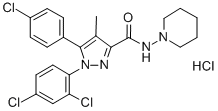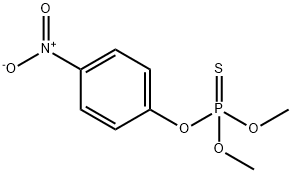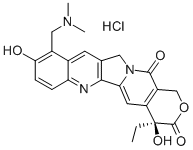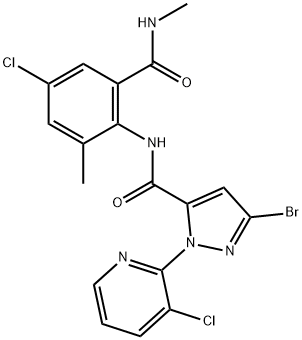Rimonabant hydrochloride
Synonym(s):5-(4-Chlorophenyl)-1-(2,4-dichlorophenyl)-4-methyl-N-1-piperidinyl-1H-pyrazole-3-carboxamide hydrochloride;SR141716;SR-141716;SR141716A;SR-141716A
- CAS NO.:158681-13-1
- Empirical Formula: C22H21Cl3N4O.ClH
- Molecular Weight: 500.25
- MDL number: MFCD00934884
- EINECS: 233-720-0
- SAFETY DATA SHEET (SDS)
- Update Date: 2023-12-07 18:29:35

What is Rimonabant hydrochloride?
Chemical properties
White to Off-White Crystalline Solid
The Uses of Rimonabant hydrochloride
Rimonabant hydrochloride has been used as an antagonist of cannabinoid 1 (CB1) receptor:
- to study its effects on protein synthesis in C2C12 myotubes
- to analyze its effects on human astroglia
- in combination with methanandamide (mAEA) to study its effects on murine gastric vagal afferent mechanosensitivity
The Uses of Rimonabant hydrochloride
The first of a new class of selective (Cannabinoid-1 (CB-1) receptor antagonists
The Uses of Rimonabant hydrochloride
A brain cannabinoid receptor (CB1) antagonist. Antiobesity agent.
What are the applications of Application
Rimonabant Hydrochloride is a CB1 (cannabinoid receptor 1) antagonist
Hazard
A poison.
Biochem/physiol Actions
Rimonabant acts as a mycobacterial membrane protein large 3 (MMPL3) inhibitor. Rimonabant hydrochloride exhibits therapeutic activity against weight reduction and smoking cessation.
storage
Desiccate at RT
Properties of Rimonabant hydrochloride
| Melting point: | 230-240°C |
| storage temp. | 2-8°C |
| solubility | DMSO: soluble20mg/mL, clear |
| form | powder |
| color | white to beige |
| CAS DataBase Reference | 158681-13-1(CAS DataBase Reference) |
Safety information for Rimonabant hydrochloride
| Signal word | Danger |
| Pictogram(s) |
 Skull and Crossbones Acute Toxicity GHS06 |
| GHS Hazard Statements |
H301:Acute toxicity,oral H319:Serious eye damage/eye irritation |
| Precautionary Statement Codes |
P305+P351+P338:IF IN EYES: Rinse cautiously with water for several minutes. Remove contact lenses, if present and easy to do. Continuerinsing. |
Computed Descriptors for Rimonabant hydrochloride
New Products
4-AMINO-TETRAHYDRO-PYRAN-4-CARBOXYLIC ACID HCL 4-(Dimethylamino)tetrahydro-2H-pyran-4-carbonitrile 4-Aminotetrahydropyran-4-carbonitrile Hydrochloride (R)-3-Aminobutanenitrile Hydrochloride 3-((Dimethylamino)methyl)-5-methylhexan-2-one oxalate 1,4-Dioxa-8-azaspiro[4.5]decane 5-Bromo-2-nitropyridine Nimesulide BP Aceclofenac IP/BP/EP Diclofenac Sodium IP/BP/EP/USP Mefenamic Acid IP/BP/EP/USP Ornidazole IP Diclofenac Potassium THOMAIND PAPER PH 2.0 TO 4.5 1 BOX BUFFER CAPSULE PH 9.2 - 10 CAP SODIUM CHLORIDE 0.1N CVS ALLOXAN MONOHYDRATE 98% PLATINUM 0.5% ON 3 MM ALUMINA PELLETS (TYPE 73) LITHIUM AAS SOLUTION 2-Bromo-1-(bromomethyl)-3-chloro-5-nitrobenzene 2-Bromo-3-nitroaniline N-(3-Hydroxypropyl)-N-methylacetamide 3-Bromo-6-chloropyridazine 4-ethyl-3-nitrobenzoic acidRelated products of tetrahydrofuran








You may like
-
 Rimonabant HCl 96% CAS 158681-13-1View Details
Rimonabant HCl 96% CAS 158681-13-1View Details
158681-13-1 -
 Rimonabant hydrochloride CAS 158681-13-1View Details
Rimonabant hydrochloride CAS 158681-13-1View Details
158681-13-1 -
 1823368-42-8 98%View Details
1823368-42-8 98%View Details
1823368-42-8 -
 2-(3-(tert-butyl)phenoxy)-2-methylpropanoic acid 1307449-08-6 98%View Details
2-(3-(tert-butyl)phenoxy)-2-methylpropanoic acid 1307449-08-6 98%View Details
1307449-08-6 -
 Ethyl 3-(furan-2-yl)-3-hydroxypropanoate 25408-95-1 98%View Details
Ethyl 3-(furan-2-yl)-3-hydroxypropanoate 25408-95-1 98%View Details
25408-95-1 -
 2-Chloro-5-fluoro-1-methoxy-3-methylbenzene 98%View Details
2-Chloro-5-fluoro-1-methoxy-3-methylbenzene 98%View Details
1805639-70-6 -
 1784294-80-9 98%View Details
1784294-80-9 98%View Details
1784294-80-9 -
 Lithium ClavulanateView Details
Lithium ClavulanateView Details
61177-44-4
Statement: All products displayed on this website are only used for non medical purposes such as industrial applications or scientific research, and cannot be used for clinical diagnosis or treatment of humans or animals. They are not medicinal or edible.